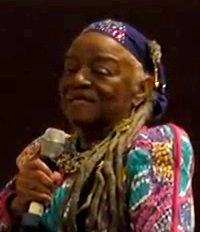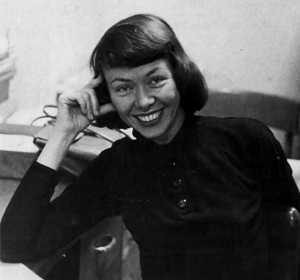Related Research Articles

Nancy Spero was an American visual artist. Born in Cleveland, Ohio, Spero lived for much of her life in New York City. She married and collaborated with artist Leon Golub. As both artist and activist, Nancy Spero had a career that spanned fifty years. She is known for her continuous engagement with contemporary political, social, and cultural concerns. Spero chronicled wars and apocalyptic violence as well as articulating visions of ecstatic rebirth and the celebratory cycles of life. Her complex network of collective and individual voices was a catalyst for the creation of her figurative lexicon representing women from prehistory to the present in such epic-scale paintings and collage on paper as Torture of Women (1976), Notes in Time on Women (1979) and The First Language (1981). In 2010, Notes in Time was posthumously reanimated as a digital scroll in the online magazine Triple Canopy. Spero has had a number of retrospective exhibitions at major museums.

Faith Ringgold is an American painter, painting on different materials including fabric, a published author, mixed media sculptor, performance artist, and intersectional activist, perhaps best known for her narrative quilts.

A.I.R. Gallery is the first all female artists cooperative gallery in the United States. It was founded in 1972 with the objective of providing a professional and permanent exhibition space for women artists during a time in which the works shown at commercial galleries in New York City were almost exclusively by male artists. A.I.R. is a not-for-profit, self-underwritten arts organization, with a board of directors made up of its New York based artists. The gallery was originally located in SoHo at 97 Wooster Street, and was located on 111 Front Street in the DUMBO neighborhood of Brooklyn until 2015. In May 2015, A.I.R. Gallery moved to its current location at 155 Plymouth St, Brooklyn, NY 11201.
Lucy Rowland Lippard is an American writer, art critic, activist, and curator. Lippard was among the first writers to argue for the "dematerialization" at work in conceptual art and was an early champion of feminist art. She is the author of 21 books on contemporary art and has received numerous awards and accolades from literary critics and art associations.
The Peace Tower, was a collaborative artwork spearheaded by the artists Irving Petlin and Mark di Suvero. The Peace Tower was created in the winter of 1966 in the West Hollywood neighborhood of Los Angeles to protest US involvement in the Vietnam War. Forty years later, Mark di Suvero, Irving Petlin, and Rirkrit Tiravanija collaborated in revisiting the project through a new installation entitled Peace Tower (2006) for the Whitney Museum of American Art in New York City to protest the Iraq War.

The feminist art movement in the United States began in the early 1970s and sought to promote the study, creation, understanding and promotion of women's art. First-generation feminist artists include Judy Chicago, Miriam Schapiro, Suzanne Lacy, Judith Bernstein, Sheila de Bretteville, Mary Beth Edelson, Carolee Schneeman, Rachel Rosenthal, and many other women. They were part of the Feminist art movement in the United States in the early 1970s to develop feminist writing and art. The movement spread quickly through museum protests in both New York and Los Angeles, via an early network called W.E.B. that disseminated news of feminist art activities from 1971 to 1973 in a nationally circulated newsletter, and at conferences such as the West Coast Women's Artists Conference held at California Institute of the Arts and the Conference of Women in the Visual Arts, at the Corcoran School of Art in Washington, D.C..
The Art Workers' Coalition (AWC) was an open coalition of artists, filmmakers, writers, critics, and museum staff that formed in New York City in January 1969. Its principal aim was to pressure the city's museums – notably the Museum of Modern Art – into implementing economic and political reforms. These included a more open and less exclusive exhibition policy concerning the artists they exhibited and promoted: the absence of women artists and artists of color was a principal issue of contention, which led to the formation of Women Artists in Revolution (WAR) in 1969. The coalition successfully pressured the MoMA and other museums into implementing a free admission day that still exists in certain museums to this day. It also pressured and picketed museums into taking a moral stance on the Vietnam War which resulted in its famous My Lai poster And babies, one of the most important works of political art of the early 1970s. The poster was displayed during demonstrations in front of Pablo Picasso′s Guernica at the MoMA in 1970.
Joan Snyder is an American painter from New York. She is a MacArthur Fellow, a Guggenheim Fellow, and a National Endowment for the Arts Fellow (1974).

May Stevens was an American feminist artist, political activist, educator, and writer.

Joyce Kozloff is an American artist known for her paintings, murals, and public art installations. She was one of the original members of the Pattern and Decoration movement and an early artist in the 1970s feminist art movement, including as a founding member of the Heresies collective.
The Women's Caucus for Art (WCA), founded in 1972, is a non-profit organization based in New York City, which supports women artists, art historians, students, educators, and museum professionals. The WCA holds exhibitions and conferences to promote women artists and their works and recognizes the talents of artists through their annual Lifetime Achievement Award. Since 1975 it has been a United Nations-affiliated non-governmental organization (NGO), which has broadened its influence beyond the United States. Within the WCA are several special interest causes including the Women of Color caucus, Eco-Art Caucus, Jewish Women Artist Network, International Caucus and the Young Women's Caucus. The founding of the WCA is seen as a "great stride" in the feminist art movement.

The Palmer Museum of Art is the art museum of Pennsylvania State University, located on the University Park campus in State College, Pennsylvania.
Cynthia Carlson is an American visual artist, living and working in New York.
New York Feminist Art Institute (NYFAI) was founded in 1979 by women artists, educators and professionals. NYFAI offered workshops and classes, held performances and exhibitions and special events that contributed to the political and cultural import of the women's movement at the time. The women's art school focused on self-development and discovery as well as art. Nancy Azara introduced "visual diaries" to artists to draw and paint images that arose from consciousness-raising classes and their personal lives. In the first half of the 1980s the school was named the Women's Center for Learning and it expanded its artistic and academic programs. Ceres Gallery was opened in 1985 after the school moved to TriBeCa and, like the school, it catered to women artists. NYFAI participated in protests to increase women's art shown at the Museum of Modern Art, The Whitney Museum of American Art and other museums. It held exhibitions and workshops and provided rental and studio space for women artists. Unable to secure sufficient funding to continue its operations, NYFAI closed in 1990. Ceres Gallery moved to SoHo and then to Chelsea and remained a gallery for women's art. However, a group continues to meet called (RE)PRESENT, a series of intergenerational dialogues at a NYC gallery to encourage discussion across generations about contemporary issues for women in the arts. It is open to all.
Vernita Nemec, also known by the performance name Vernita N'Cognita, is a visual and performance artist, curator, and arts activist based in New York City. She earned her BFA at Ohio University in 1964 and has resided in New York City since 1965. She is also known for her soft stuffed sculpture, collages, artist's books, photographs, and installations. Nemec adopted the pseudonym "N'Cognita," a pun on incognito, as a way to honor artists who have not become well-known.
West-East Bag (WEB) was an international women artists network active from 1971 to 1973.
The first known reference to an Art Strike appears in an Alain Jouffroy essay: "What's To Be Done About Art?".
Women Artists in Revolution (WAR) was a New York City-based collective of American women artists and activists that formed in 1969. They seceded from the male-dominated Art Workers' Coalition (AWC), prompted by the Whitney Museum of American Art's 1969 Annual (later the Whitney Biennial), which included only eight women out of the 143 featured artists shown.
Women Artists News was a feminist magazine produced between 1975 and 1992 in New York City.

We Wanted a Revolution: Black Radical Women, 1965–85 was an exhibition held at the Brooklyn Museum of Art from April 21, 2017, through September 17, 2017 surveying the last twenty years of black female art. The exhibition was organized thematically, presenting forty artists and activists whose work was dedicated to the fight against racism, sexism, homophobia, and class injustice.
References
- 1 2 3 4 5 6 Bryan-Wilson, Julia (2012). "Still Relevant: Lucy R. Lippard, Feminist Activism, and Art Institutions". In Morris, Catherine (ed.). Materializing Six Years: Lucy Lippard and the Emergence of Conceptual Art. Cambridge, MA: MIT Press. p. 81. ISBN 978-0-262-01816-6.
- 1 2 3 Wallace, Caroline (April 27, 2017). "Three Lessons from Artists' Protests of the Whitney Museum in the 1960s-70s". Hyperallergic. Retrieved March 30, 2018.
- 1 2 Lippard, Lucy R. (1976). From the Center: Feminist Essays on Women's Art. New York: E.P. Dutton. p. 47. ISBN 978-0-525-48402-8.
- 1 2 3 4 Meller, Sarah (May 3, 2010). "The Biennial and Women Artists: A Look Back At Feminist Protests At The Whitney". Whitney Museum of American Art. Retrieved 2024-04-10.
- ↑ "A 1973 document of feminist art activism holds a mirror to our present". www.bookforum.com. Retrieved 2023-04-15.
- ↑ Ault, Julie (1996). Alternative Art New York 1965-1985. Minneapolis: University of Minnesota Press. pp. 28–29. ISBN 978-0-8166-3793-5.
- ↑ "Miriam Schapiro Archives on Women Artists". Rutgers University Libraries. 2018. Retrieved November 2, 2018.
- 1 2 Lamm, Kimberly (2018). Addressing the Other Woman: Textual Correspondences in Feminist Art and Writing. Manchester: Manchester University Press. p. 126. ISBN 978-1-5261-2126-4.
- ↑ "Finding Aid to the Mary H. Dana Women Artists Series Collection, 1971-ongoing". Rutgers University Libraries. Retrieved April 4, 2018.